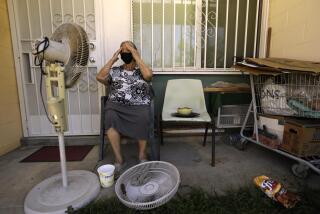CUT YOUR UTILITY BILLS : Window Film Can Help Block Heat From Sun
QUESTION: The hot sun shining in our windows literally bakes us and fades our furniture and carpets. What can I do to our windows to block the sun in the summer, but still let it shine in for solar heat in the winter?
ANSWER: Blocking the intense summer sun through your windows reduces your air-conditioning costs and increases your comfort. It also greatly reduces the fading and deterioration of your furniture, curtains and carpeting.
There are several inexpensive do-it-yourself methods to block the sun in your windows. These sun-control methods are designed so you can remove them each winter if you want to capture some free solar heat through your windows.
A very effective summer-only control is a new type of self-cling reusable tinted (gray or bronze) window film you can install yourself. You can reinstall it each spring in just a couple of minutes. Peel it off each fall and roll it up until time to install it again next spring.
Unlike standard year-round sun-control window film that uses a permanent adhesive, the durable reusable film sticks to the window glass by static electricity. The natural properties of the thin tinted vinyl film create the tiny natural static charge to hold it firmly to the glass. To remove it in the fall, you just lift up a corner and pull it off the glass.
This tinted vinyl blocks more than 50% of the sun’s heat, yet still provides a sharp, undistorted view through the windows. The sun’s ultraviolet rays, which fade and destroy your furniture through your windows, are reduced by more than 80%. With the film applied, the window glass is also more shatter-resistant from impacts and high winds.
You can purchase self-cling window film in small rolls. Using scissors, cut a piece of film slightly larger than your window. Wet the window and the film (either side since there is no adhesive) with a common spray window cleaner. Place it on the window and squeegee it flat to the glass. When it dries, cut off the excess around the edge with a sharp utility knife.
You can also install special fiberglass sun-control window screening in your existing window screen frames. This very durable screening blocks 70% of the sun’s heat and fading rays.
Although this screening is a closer weave than standard screening, you can still see through it easily and it won’t block breezes through an open window. You should be able to install the screening in the frame yourself.
You can write to me for Utility Bills Update No. 057 listing addresses and telephone numbers of manufacturers of reusable self-cling window film and sun-blocking screening, sun-blocking performance specifications and small sample pieces of the self-cling film and the special screening. Please include $1.50 and a self-addressed business-size envelope.
Newer Energy-Efficient Glass Difficult to Detect
Q: I had new replacement windows installed two months ago. I was told by the installer (and paid extra) that these had low-emissivity (low-e) glass. How can I tell if they really are low-e glass?
A: The newer energy-efficient low-e window glass is difficult to detect with the eye. They look almost totally clear without the slight bluish tint of the older type of low-e glass.
There are special detectors available that can sense the low-e coating. Some window contractors have them. Your utility company may also have them to test installations before giving conservation rebates or credits.
Roof Felt Provides Protection From Leaks
Q: I have been told that roof felt under the shingles is needed as a vapor barrier for unvented attics. Does roof felt save much energy?
A: First of all, roof felt is not used as a vapor barrier and all attics should be vented. The thin layer of material directly under the shingles has no significant effect on the energy efficiency of your house.
There are several benefits from using roof felt when roofing. The felt provides a quick protective covering for the roof deck and the interior of the house while the roofing is being applied. It also provides extra leak protection against strong wind-driven rain or when a shingle is blown off.

